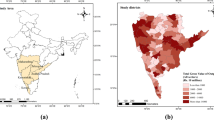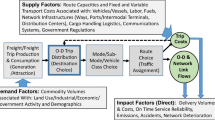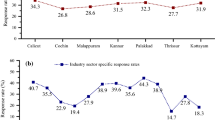Abstract
This paper investigates the application of linear regression models and modeling techniques in predicting freight generation at the national level within the U.S. Specifically, the paper seeks to improve the performance and fit of linear regression models of freight generation. We provide insight into different variable transformation techniques, evaluate the use of spatial regression variables, and apply a spatial regression modeling methodology to correct for spatial autocorrelation. We conclude that the spatial regression model is the preferred specification for freight generation at the national level. The proliferation of Geographic Information Systems (GIS) within planning agencies affords more widespread use of spatial regression and our results indicate this technique would provide improvement to models that have been traditionally limited by insufficient data.
Similar content being viewed by others
Notes
RESET adds polynomials in the OLS fitted values from the estimated model to detect general kinds of functional form misspecification (Wooldridge 2003, pg.293).
The Davidson Mackinnon (1981) test involves several steps. First, the levels (untransformed) model is estimated and the fitted (predicted) values are obtained. Second, the log-transformed model is estimated and the fitted values are obtained. Third, a new variable is created equal to difference between the fitted values from the estimation of the transformed model and the log of the fitted values from the levels model (i.e., fitted values from the log-transformed model minus the log of the fitted values from the levels model). Finally, this new variable is added to the levels model and tested for statistical significance. If the levels model is correctly specified, the new variable should not be statistically significant. Thus, statistical significance suggests that the model is not correct.
References
Agyemang Duah K, Hall F (1997) Spatial transferability of an ordered response model for trip generation. Transportation Research Part A 31a(5):389–402
Al-Deek HM (2001) Comparison of two approaches for modeling freight movement at seaports. Journal of Computing in Civil Engineering (October), 284–291. doi:10.1061/(ASCE)0887-3801(2001)15:4(284)
Al-Deek HM, Johnson G, Mohamed A, El-Maghraby A (2000) Truck trip generation models for seaports with container and trailer operation. Transportation Research Record 1719:1–9. doi:10.3141/1719-01
Aultman-Hall L, Johnson B, Aldridge B (2000) Assessing potential for modal substitution from statewide freight commodity flow data. Transportation Research Record 1719:10–16. doi:10.3141/1719-02
Bell MGH (2000) A game theory approach to measuring the performance reliability of transportation networks. Transportation Research Part B: Methodological 34:533–545. doi:10.1016/S0191-2615(99)00042-9
Bell MGH, Iida Y (1997) Transportation network analysis. Wiley, New York
Bhat C, Zhao H (2002) The spatial analysis of activity stop generation. Transportation Research Part B 36:557–575. doi:10.1016/S0191-2615(01)00019-4
Cambridge Systematics Inc. Leeper CC I, Sydec Inc., Thomas M, Corsi, and Curtis M. Grimm. (1997). “A Guidebook for Forecasting Freight Transportation Demand.” NCHRP 388, Transportation Research Board, Washington D.C.
Chatterjee A (2004) Freight transportation planning for urban areas. ITE Journal 74(12):20–24
Chen A, Yang H, Hong KL, Tang WH (2002) Capacity reliability of a road network: an assessment methodology and numerical results. Transportation Research B: Methodological 36:225–252
Cook RD, Weisberg S (1983) Diagnostics for heteroskedasticity in regression. Biometrika 70:1–10. doi:10.1093/biomet/70.1.1
Crainic TG (2002) Long haul freight transportation. Handbook of transportation science, chapter 13, 2nd edn. Kluwer, Dordrecht, pp 451–515
Davidson R, MacKinnon JG (1981) Several tests for model specification in the presence of alternative hypotheses. Econometrica 49:781–793. doi:10.2307/1911522
De Jong G, Gunn H, Walker W (2004) National and international freight models: an overview and ideas for future development. Transport Reviews 24(1):103–124
Eatough C, Brich J, Stephen C, Demestsky MJ (2000) A statewide intermodal freight transportation planning methodology. Journal of Transportation Research Forum 39(1):145–155
Feitelson E, Salomon I (2000) The implications of differential network flexibility for spatial structures. Transportation Research Part A: Policy and Practice 34:459–479. doi:10.1016/S0965-8564(99)00028-2
Fisher M, Ang-Olson J, La A (2000) External urban truck trips based on commodity flows: a model. Transportation Research Record 1707:73–80. doi:10.3141/1707-09
Fotheringham AS, Brunsdon C, Charlton M (2000) Quantitative geography. SAGE, London
Garrido RA, Mahmassani HS (2000) Forecasting freight transportation demand with the space–time multinomial probit model. Transportation Research Part B 34:403–418. doi:10.1016/S0191-2615(99)00032-6
Giuliano G, Gordon P, Pan, Qisheng, Park, J., Wang, L. (2007) Estimating freight flows for metropolitan area highway networks using secondary data sources. Networks and Spatial Economics (in press). DOI 10.1007/s11067-007-9024-9. [online] http://www.springerlink.com/content/871647u167624630/fulltext.pdf
Guo F, Aultman-Hall L (2005) Alternative nationwide freight generation models. Proceedings of the Transportation Research Board 84th Annual Meeting, Washington DC, January 2005.
Holguín-Veras J (2001) An assessment of methodological alternatives for a regional freight model. Appendix I: literature review on freight transportation demand modeling. New York Metropolitan Transportation Council Report. New York, NY. [online] http://www.utrc2.org/research/assets/6/regionalfreight2.html
Holguín-Veras J, Patil GI (2007) A multicommodity integrated freight origin–destination synthesis model. Networks and Spatial Economics (in press). doi 10.1007/s11067-007-9053-4 [online] http://www.springerlink.com/content/t37383g855531542/fulltext.pdf
Holguín-Veras J, Lopez-Genao Y, Salam A (2002) Truck-trip generation at container terminals: results from a nationwide survey. Transportation Research Record, 1790:89–96
Huang WJ, Smith RL Jr. (1999) Using commodity flow survey data to develop a truck travel-demand model for Wisconsin. Transportation Research Record 1685:1–6. doi:10.3141/1685-01
Miller HJ (1999) Potential contributions of spatial analysis to Geographic Information Systems for Transportation (GIS-T). Geographical Analysis 31:373–399
Morlok EK, Chang DJ (2004) Measuring capacity flexibility of a transportation system. Transportation Research Part A: Policy and Practice 38:405–420. doi:10.1016/j.tra.2004.03.001
Nijkamp P, Reggiani A, Tsang WF (2004) Comparative modelling of interregional transport flows. European Journal of Operational Research 155(3):584–602. doi:10.1016/j.ejor.2003.08.007
Ortuzar JdD, Willumsen LG (2001) Modeling transport, 3rd edn. Wiley, West Sussex
Pendyala RM, Shankar VN, McCullough RG (2000) Freight travel demand modeling. Synthesis of approaches and development of a framework. Transportation Research Record 1725:9–18. doi:10.3141/1725-02
Ramsey JB (1969) Tests for specification errors in classical least-squares regression analysis. Journal of the Royal Statistical Society: Series B 31:350–371
Regan AC, Garrido R (2001) Freight demand and shipper behavior modeling: state-of-the-art, directions for the future. In: Hensher DA, King J (eds) The leading edge of travel behavior research. Pergamon, New York
Scott DM, Novak DC, Aultman-Hall L, Guo F (2006) Network robustness index: a new method for identifying critical links and evaluating the performance of transportation networks. Journal of Transport Geography 14:215–227. doi:10.1016/j.jtrangeo.2005.10.003
Sorratini JA, Smith RL Jr. (2000) Development of a statewide truck trip forecasting model based on commodity flows and input–output coefficients. Transportation Research Record 1707:49–56. doi:10.3141/1707-06
Southworth F (2003) Freight transportation planning: models and methods. Transportation Systems Planning, Konstadinos, CRC, New York
Tadi RR, Balbach P (1994) Truck trip generation characteristics of nonresidential land uses. ITE Journal 64(7):44–47
U.S. Army Corps of Engineers (USACE). (2005). A survey of the freight transportation demand literature and a comparison of elasticity estimates. January 1, 2005. The Navigation Economic Technologies Program, IWR Report 05-NETS-R-01. [online] http://www.nets.iwr.usace.army.mil/docs/other/05-NETS-R-01.pdf
U.S. Department of Commerce, Census Bureau, and U.S. Department of Transportation, Bureau of Transportation Statistics. (2002). Commodity Flow Survey (CFS), December 2006. [online] http://www.bts.gov/publications/commodity_flow_survey/index.html
Wigan MR, Southworth F (2006) What’s wrong with freight models, and what should we do about it? Proceedings from the 85th Annual Meeting of the Transportation Research Board, CD-ROM.
Wisetjindawat W, Sano K, Matsumoto S (2006) Commodity distribution model incorporating spatial interactions for urban freight movement. Transportation Research Record 1966:41–50. doi:10.3141/1966-06
Wooldridge JM (2003) Introductory econometrics. A modern approach. Thomson/South-Western, Mason
Zhang P, Peeta S, Friesz T (2005) Dynamic game theoretic model of multi-layer infrastructure networks. Networks and Spatial Economics 5:147–178. doi:10.1007/s11067-005-2627-0
Acknowledgements
The work is this paper was partially supported by a grant from the U.S. Bureau of Transportation Statistics. A preliminary version of the paper was presented by Guo and Aultman-Hall (2005) at the 84th Annual Meeting of the Transportation Research Board in Washington DC, January 2005. The authors thank Reebie Associates for their support and for provision of the freight data without which this analysis could not have been completed.
Author information
Authors and Affiliations
Corresponding author
Rights and permissions
About this article
Cite this article
Novak, D.C., Hodgdon, C., Guo, F. et al. Nationwide Freight Generation Models: A Spatial Regression Approach. Netw Spat Econ 11, 23–41 (2011). https://doi.org/10.1007/s11067-008-9079-2
Published:
Issue Date:
DOI: https://doi.org/10.1007/s11067-008-9079-2




